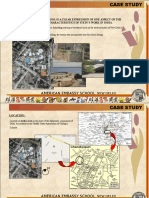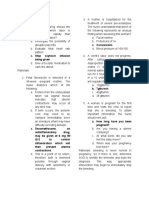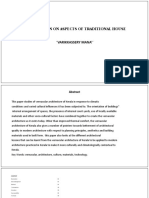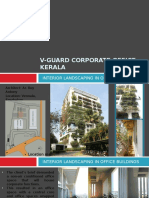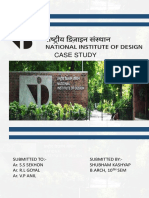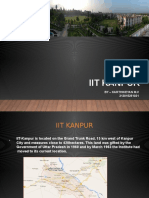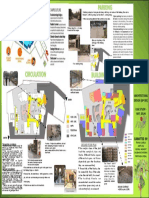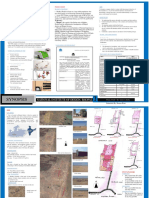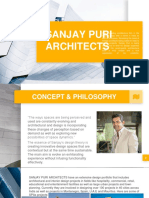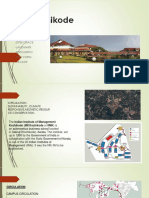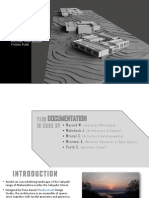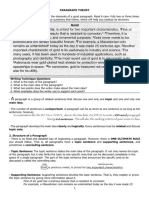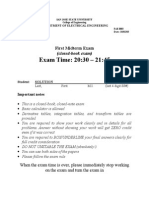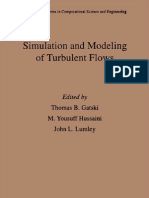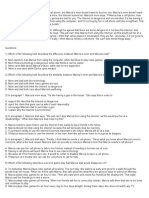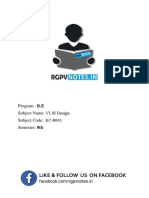Iucaa Case Study
Uploaded by
63 Aamer AliIucaa Case Study
Uploaded by
63 Aamer AliINTER-UNIVERSITY CENTRE FOR ASTRONOMY
AND ASTROPHYSICS
CLIMATE ANALYSIS
LOCATION: University of Pune Campusepost Bag-4, University
Road, Maharashtra Pune has a hot semi-arid climate bordering tropical wet and dry with average
SETTLEMENT TYPE: Urban temperatures ranging between 19 to 33 Deg Celsius.
APPROX SITE AREA: 43,000 SQ.M Pune experiences three seasons: Summer, Monsoon, and Winter.
APPROX BUILT-UP AREA: 8997 SQ.M Annual rainfall: 47.2 inch
NO.OF FLOORS: Ground floor: housing-G+1
FUNCTIONAL TYPOLOGY: Research Institute, Experimental
Museum
ESTABLISHED IN: 1998
ARCHITECT: Charles Correa
SOLAR CHART
AIM & OBJECTIVE OF THE PROJECT :
IUCAA was created to serve the teaching, research, and development
of astronomy and astrophysics in the university section. It is planned
with an eight-fold objective.
1. Basic research
2. Advanced research school and workshops
3. Visitors and associate programs
4. Refresher courses
5. Helping nucleation of astronomy and astrophysics between
universities
6.M.Sc. And Ph.D. programs
7. Guest observer programs
8. Interaction With GMRT
VEGETATION ON SITE
CASE STUDY – IUCAA , PUNE
SITE PLAN
IUCAA, known as the Inter-University Center for Astronomy and Astrophysics,
represents a model of the cosmos. The building itself is perfect for its purpose.
It has three main courtyards flanked by the various functions and two main roads
passing toward its periphery which marks the importance of this building.
The complex is situated in 3 individual plots of land, with a total area is around
4.3 hectares, which is equal to about 10 acres. The 3 distinct sections are –
1. AKASHGANGA – Housing complex
2. DEVYANI – Institutional complex
3. ADITI – Auditorium The site consists of three contiguous pieces of
land, with two campus roads passing between
The main activity core is Devyani, while Aditi and Akashganga are supplementary. them.
The entire layout is such that all the spaces are within walkable distances. The
total built-up area is over 1,50,000 sq. ft. The campus is provided with facilities
for indoor games such as table tennis, carrom, chess, and outdoor games like
cricket and badminton.
CASE STUDY – IUCAA , PUNE
SPATIAL PLANNING BLOCK 1- BRAHMAGUPTA
ARYABHATA – It is the main academic core of IUCAA and
consists of 4 main blocks, each having different activities
grouped around a central court, a Library with adjoining
librarian’s rooms, stores, a binding room, etc.
COMPUTER CENTRE – The computer center has a network of
some 30 supercomputer workstations, which can be shared by
an ethernet link throughout the Aryabhata block.
These labs are again divided as; computer lab- 500 sq.m and
electrical lab170 sq.m
DINING FACILITY – This includes a spacious dining hall for • The most elegant of all the buildings is
students, and faculty members and an air-conditioned VIP DINING LIBRARY COMPUTER LAB ELECTRONIC LAB
the, Library housed in the block
dining hall for visitors, along with the adjoining kitchen and • Containing some 20,000 books and
pantry area with a separate canteen area. subscribing to scientific journals.
Dining Area-230 sq.m, Kitchenette And pantry-100 sq.m • Large openings from courtyards do that
no need for artificial ventilation.
• It has a column size of 300mm.
• The roof of the library has been
KEY PLAN constructed using hollow concrete
blocks and in-situ beams.
The library has formal More private and
Mezzanine level
and informal seating more concentration
3 1
ROCHE LOBE
2 One of the smaller courtyards flanking the
CORRIDOR central one is designed as a Binary Star-
accommodating two ficus trees already growing
STAIRCASE with the courtyard
RESIDENTIAL AREA DINING/CANTEEN
EDUCATIONAL INSTITUTE DOME
CASE STUDY – IUCAA , PUNE
SPATIAL PLANNING BLOCK 3-ARYABHATA
Block 3 has Lecture Halls and Faculty Offices
FACULTY OFFICES – About 50 cabins, (40 on each floor ) are
provided for the training faculty of the institute and the research
scholars. Groups of 6-8 cabins derive their ventilation from open
courtyards and are grouped linearly. Seminar rooms and conference
ENTRY
rooms have an area of 36 sq.m for faculty and are also provided in the
same wing.
LECTURE HALLS- There are 3 in number. Each has 40 people-60
sq.m
One of them is well equipped with a projector as teaching through the DEVYANI BLOCK STUDENT LOUNGE
films and slides medium is a necessary part of astronomy and ENTRY
astrophysics. This structure has double atrium.
The lecture hall opens out into a common student lounge and common FACULTY It has waiting area and administrative space
CORRIDOR ADMIN LOUNGE
room, keeping the feeling of interaction alive. OFFICES
KEY PLAN
WAITING AREA SEMINAR ROOM /CABIN ROOMS
4 In the Double Atrium of staff rooms a pendulum is
suspended from the roof and below is spiral-shaped pit
with the circular dial of cardinal directions 0.6 m below
floor level
3 1
RESIDENTIAL AREA DINING/CANTEEN
EDUCATIONAL INSTITUTE DOME
CASE STUDY – IUCAA , PUNE
SPATIAL PLANNING BLOCK 4- NALANDA
ENTRY
Block 4 is named by NALANDA has a guest house, hostel rooms, and
Seprenski’s triangle
The courtyard of the scholar’s room is the presentation of Seprenski’s
triangle, one of the key images of Froctal theory representing how
macro patterns are repeated identically and endlessly.
AREA –Approx 660 sq.m
HOSTEL BLOCK- Rooms housing two students each with a toilet and
a shared balcony are grouped around a central open-to-air courtyard.
The hostel block is connected to the main block using a recreational
lounge and connected on the other side to the guest room block. Serpenski’s gasket is a unique gardening
Hostel rooms-25 ( Each 16 sq.m) texture triangular in shape
Toilets- 30 sq.m
Common room- 80 sq.m
LIMITED ACCESS
GUEST HOUSE HOSTEL BLOCK CORRIDOR FACING
ROOM COURTYARD
KEY PLAN
SHARED
4 BALCONY BATH
BINARY STAR TRESS
HOSTEL BLOCK
PLANTED HERE ARE
ENTRY FROM BLOCK
VERY INTRIGUIING
3
3 1
RESIDENTIAL AREA DINING/CANTEEN
DOME GROUND FLOOR FIRST FLOOR
EDUCATIONAL INSTITUTE
CASE STUDY – IUCAA , PUNE
BLOCK VIEW BLOCK 2-BHASKARA
KEY PLAN
CORRIDOR
LECTURE HALLS
4
OPEN SPACE
TOILETS These classrooms have an occupancy
of 50 people,70 people, and 100
3 1
STAIRCASE people
The wall facing the courtyard has huge
2 openings and Jali works for natural
CLASSROOMS ventilation.
Here the staircase designed
RESIDENTIAL AREA DINING/CANTEEN
are straight stairs opening into
the corridor
EDUCATIONAL INSTITUTE DOME
CASE STUDY – IUCAA , PUNE
SITE PLAN ELEVATIONS AND DETAILS
Every block has large
BLOCK 1- ELEVATION openings
This dome structure is constructed for tracing the positions
VENTILATION AND LIGHT BLOCK 2- ELEVATION of stars and observing the reflection of stars
• The whole structure of IUCAA has complete natural ventilation.
• The open spaces in the Black hole garden and other such
courtyards allow free flow of air for ventilation.
• IUCAA doesn’t have many classrooms except for laboratories.
• The whole structure has more than enough sunlight to brighten
the day.
• There are numerous voids made in the walls so that the sunlight BLOCK 3 - ELEVATION
passes through those voids and shines everywhere.
STRUCTURE
• Planning is basically on a square grid and the structural systems
of R.C.C. column, beam, and slab grid of 5-6m is used.
• Distribution and circulation of various activities on the site are
appropriate.
FINISHES AND MATERIALS
• External curved walls are of Khadki stone masonry, Grey
NALANDA-
slate/Shahabad stones, and black granite.
HOSTEL VIEWS
• Walls facing the courtyard are of cement plaster of smooth type
with pastel shades of acrylic distemper, buff, pink, and purple.
• External passages are of unpolished/polished, marble and cement
blocks.
• External ground cover with stone paving with grass joints.
CASE STUDY – IUCAA , PUNE
MATERIALS GRANITE
AUDITORIUM
BASALT STONE
KADAPPA STONE
AREA (sq.m)
5% 9%
9% 3%
4%
6%
23%
RAMPS
8%
4%
29%
Admin Maintenance Public dept central store computer centre
library staff-rooms Academic areas Canteen area Hostel
CASE STUDY – IUCAA , PUNE
You might also like
- Case Study Non Architectural Mdi GurgaonNo ratings yetCase Study Non Architectural Mdi Gurgaon12 pages
- Architectural DESIGN (AP-301) Case Study - Nift, DelhiNo ratings yetArchitectural DESIGN (AP-301) Case Study - Nift, Delhi1 page
- National Institute of Design, Bhopal: Synopsis100% (1)National Institute of Design, Bhopal: Synopsis9 pages
- Literature Study: Trivandrum Public Library / State Central Library100% (2)Literature Study: Trivandrum Public Library / State Central Library5 pages
- IIM Kozhikode: - Circulation - Open Space - Landmark - Topogrphy - Built Form - Facade100% (1)IIM Kozhikode: - Circulation - Open Space - Landmark - Topogrphy - Built Form - Facade7 pages
- Dissertation-Synopsis Review: Title: "Developing Abandoned Quarries Into Liveable Spaces"No ratings yetDissertation-Synopsis Review: Title: "Developing Abandoned Quarries Into Liveable Spaces"11 pages
- Design Concept: Architect: Neelkanth Chhaya100% (1)Design Concept: Architect: Neelkanth Chhaya6 pages
- Triveni Kala Sangam India International Center Case StudyNo ratings yetTriveni Kala Sangam India International Center Case Study1 page
- Gautham Budha University: - Noida, UttarpradeshNo ratings yetGautham Budha University: - Noida, Uttarpradesh17 pages
- Implementation-of-Barangay-Disaster-Risk-Reduction-and-Management-Council-BDRRMC-in-the-Flood-Prone-Areas-in-Tantangan-REVISE 1100% (1)Implementation-of-Barangay-Disaster-Risk-Reduction-and-Management-Council-BDRRMC-in-the-Flood-Prone-Areas-in-Tantangan-REVISE 181 pages
- Simulation and Modelimg of Turbulent Flows - Lumley J.L.No ratings yetSimulation and Modelimg of Turbulent Flows - Lumley J.L.329 pages
- Department of Mathematics Anna University, Chennai Ma5252 Engineering Mathematics-Ii Unit - III Complex IntegrationNo ratings yetDepartment of Mathematics Anna University, Chennai Ma5252 Engineering Mathematics-Ii Unit - III Complex Integration36 pages
- ban-sao-cua-question-aldehydes-and-ketonesNo ratings yetban-sao-cua-question-aldehydes-and-ketones15 pages
- Unit 1 - VLSI Design - WWW - Rgpvnotes.inNo ratings yetUnit 1 - VLSI Design - WWW - Rgpvnotes.in13 pages
- Architectural DESIGN (AP-301) Case Study - Nift, DelhiArchitectural DESIGN (AP-301) Case Study - Nift, Delhi
- Literature Study: Trivandrum Public Library / State Central LibraryLiterature Study: Trivandrum Public Library / State Central Library
- IIM Kozhikode: - Circulation - Open Space - Landmark - Topogrphy - Built Form - FacadeIIM Kozhikode: - Circulation - Open Space - Landmark - Topogrphy - Built Form - Facade
- Dissertation-Synopsis Review: Title: "Developing Abandoned Quarries Into Liveable Spaces"Dissertation-Synopsis Review: Title: "Developing Abandoned Quarries Into Liveable Spaces"
- Triveni Kala Sangam India International Center Case StudyTriveni Kala Sangam India International Center Case Study
- Implementation-of-Barangay-Disaster-Risk-Reduction-and-Management-Council-BDRRMC-in-the-Flood-Prone-Areas-in-Tantangan-REVISE 1Implementation-of-Barangay-Disaster-Risk-Reduction-and-Management-Council-BDRRMC-in-the-Flood-Prone-Areas-in-Tantangan-REVISE 1
- Simulation and Modelimg of Turbulent Flows - Lumley J.L.Simulation and Modelimg of Turbulent Flows - Lumley J.L.
- Department of Mathematics Anna University, Chennai Ma5252 Engineering Mathematics-Ii Unit - III Complex IntegrationDepartment of Mathematics Anna University, Chennai Ma5252 Engineering Mathematics-Ii Unit - III Complex Integration

